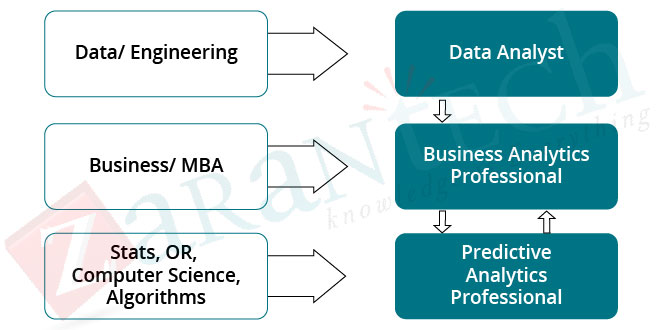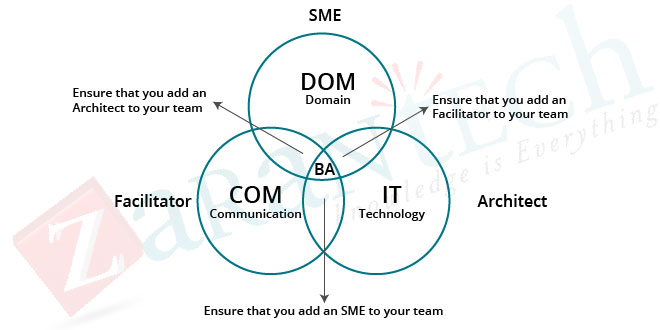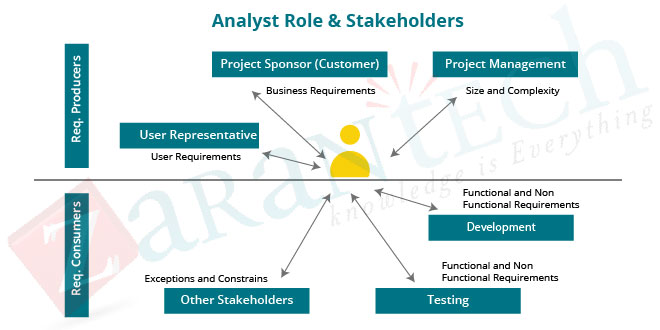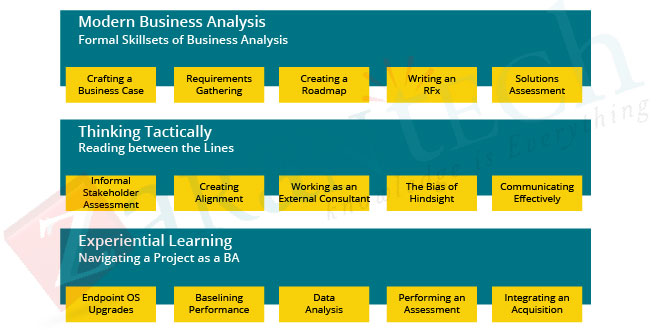6 Easy Steps to Switch your Career from a Developer Role to Business Analyst
Category: Agile Business Analysis Posted:Mar 13, 2017 By: Serena Josh
A company is moving to the cloud and they say they will need fewer programmers and more Business Analysts. This leads you as a programmer asking, how do I become a Business Analyst? You are a Database Manager, good Software Engineer, or Software Quality assurance professional that has recently discovered that business analysis is the role you are perfect for. How do you go from a technical role to a business analysis role?
If these questions are plaguing you and who need definitive answers to the same, then you are among many who are facing problems as aspiring business analysts currently in technical positions. Then look no more! Here is the definitive guide to help you as a developer to switch to a promising career as a Business Analyst or BA.
While having solid technical skills can be a great starting point for someone looking to develop a career in BA. The biggest obstacle for IT professionals interested in pursuing a BA career is the deficiency of well-developed business skills. Soft skills are the set of skills including the ability to communicate with clarity, precision and eloquence, qualities of working well with other people and building effective contacts and relationships throughout the organization, and so on. One might even debate that such skills are more important for a BA than being business-savvy. But it can be deduced that software engineers who are passionate about BA already value and develop their soft skills which are transferable across job roles. Therefore it’s usually not the main skill gap they face when trying to switch to a BA position.

Understanding things like revenue streams and profit centres, on the other hand, may need thought processes that are relatively unfamiliar to typically technical people. It is widely known that, IT professionals are more skilled at writing highly efficient code, and producing software rich and features and functions. But this does not help stakeholders determine the right set of project needs capable of balancing the needs of the users company and the market.

To help professionals who are currently working as developers and are aspiring to break into BA Analysis roles in any organization here is a list of steps to help switch a career from a Developer role to a BA role:
1. Understand the BA role and Learn to think like a Business Analyst.
BA has at its core three fundamental job functions. To start with, it serves as a liaison between programmers creating the software and business users requesting the same. Secondly, it is the consolidation of business requirements from the business users and its conversion into a Business needs a document that is utilized by programmers as the basis for the software being developed.

A BA also executes several other vital tasks depending on the organization and the project scenario. The tasks consist of software testing, implementation of cloud-based products, project management, and software training/rollout.
Get More Insights about business analysis with Free Live Webinar
The mind-set of a developer is totally different from what is necessary as a BA. Software developers are typically responsible for generating code, and not required to gain an understanding of the business reasons for the code. All business questions, scenarios and concerns should have been addressed and resolved by the time it’s the developer’s turn to code.
While a developer gets into the minutia of the coding aspects, the developer is bound to lose the bigger the picture, in terms of why the code is being generated in the first place. This is where the BA comes in with a more comprehensive look of what is required in terms of the software specifications leading up to the business needs the software is meant to meet or fulfil. A BA holds the all-important set of tasks to direct and guide the project in such a way that the developer will only have to build the code and nothing more.
To make the transition from developer to BA a professional will have to start asking the questions that BA’s are supposed to ask. Some of these are – Who will the code help? Why is the software code required in the first place? Where will the code be used by the business? What business problem will it solve? How can the software be leveraged for future business capabilities? And many more like these.
2. Understanding the needed BA skills and Doing a personal gap assessment
BA skills are completely different as compared to a programmer. The principal skill required to be a programmer is the capability to write, implement, and maintain software. The chief skills required to be a BA are requirements gathering, communication with business, IT people, and document writing. Skills such as product selection, project management, software testing, giving presentations and other related project-oriented functions may also be needed based on the specific organization in order to be a BA.
An aspiring BA must objectively and purposefully do a personal assessment, comparing professional skills, experiences, strengths, and weaknesses against the particular tasks performed by the BAs at the current company.
Periodically reassess your competence gap and make sure you have a plan to address them.
If you haven’t started yet, read business books, and blogs such as the ones from Harvard Business, as well as resources that can help you build your BA skills.
3. Leverage your technical knowledge as an asset while showing your interest in becoming a Business Analyst
Having a software development background is a great asset to a Business Analyst. It permits a professional to act as an optimal bridge between the business and IT. This is because you are able to speak the technical language of IT. Working in the role of a developer also provides one insight into what is possible with coding, and also how systems and applications and may be modified to provide future business capabilities.
All this can be easily translated into dynamic skill assets while functioning as a BA, bringing in vast technical knowledge and skill to facilitate better BA processes.
As soon as a professional recognizes the desire to switch from developer to BA, it is recommended to express the said interest as soon as is possible. This would position the professional to receive available BA opportunities faster. This will usually happen in terms of small BA oriented tasks being assigned to the professional. These tasks may include defining the business requirements for a new report or small system upgrade and meeting with business users.
4. Pick a business specialty and Build the needed skills
This refers to selecting the specific business area to expand your knowledge. If a professional has experience in programming systems in the Payroll department, it is advisable to specialize in payroll systems. While this doesn’t necessarily mean that payroll will be the only area where you will get to specialize and work on, it can give one a head start while beginning as a BA. In essence it will provide one with an initial area of business expertise. Since a BA is the principal gatherer of business needs, the better one understands the business area being worked on, the easier it will be for a professional to define the mentioned requirements.

Following selection of area to specialize in, a professional can go about building knowledge and skills based on personal assessment conducted. This can happen through permutations of participation in MOOC type classes, company sponsored training and most effectively, online certifications.
You as a professional can learn The Business Analysis Body of Knowledge which is considered as the BA’s bible, metaphorically speaking! It is good to be familiar with it as it goes over all fundamental BA techniques and concepts.
Core competencies in BA include re-engineering business processes and documenting them. It is good to work on pre-existing skills such as documenting data flows, sequence diagrams, and workflows. This may give one an added edge as a BA.
5. Understand the role of software in the larger system and business.
In most cases, a software developer will know the ins and outs of the piece of code that he creates, and will be wholly dedicated to the same to live up to the ownership and responsibilities it will bring up. But as a BA one will have to understand how components of software while being integrated into a larger whole as a software product. Also one will have to learn how the business capabilities are enabled by applications and systems of systems, interaction of human users with those systems, the interfaces to other applications and systems will function.
6. Get involved with the business, volunteer to perform Business Analyst related tasks and finally assume the role of BA
It is recommended to get pro-active and start sitting in on meetings that define business strategy and analyse business needs. But this should be done only after thoroughly familiarising a company’s BA’s and seeking permission to sit in on the requirements sessions. It is of paramount importance to learn business perspective and what it intends to achieve. While trying to do all this it is very possible that one may pick up a few mentors along the way helping the transition to BA.
As one’s professional knowledge and skills start to grow, one should begin volunteering to execute BA type tasks. Considering that a professional has followed the steps above, and have already expressed an interest in becoming a BA the new skills you are beginning to acquire, and your strong technical background, one should be well positioned to be trusted to execute these types of tasks.
That is to say, ask to be included in the meeting with business users, talk about software benefits to the business rather than application features and technical details. Most importantly, as time progresses, one should begin talking and executing tasks more and more like a BA. Learn to “talk the talk” of business analysts.
In essence, the final step in this process would involve trying to get others to begin thinking of you as a BA with a strong technical background, rather than as a programmer moving toward BA. This would cement a professional’s image as a BA and garner widespread acceptance and acknowledgment as a BA throughout the organization.
Conclusion
As with any transition, it is good to make the change from the developer role to BA role in a planned and systematic manner. A professional will have to do a thorough research of BA role and self-assessment of pre-existing skills and find the skill and experience gaps to fill. Once the gaps are identified, it is advisable to brand oneself as a BA through the tasks the professional opts for and the responsibilities taken on, with the objective of transforming into a full-fledged BA. Once the transformation is complete in terms of job responsibilities and job title and designations, it is hugely beneficial to increase role visibility through personal online branding campaigns within the organization. If the said steps are followed sequentially, there is no doubt that you will end up as one of the best BA’s in the organization with a huge set of universal and transferable business skills!
I hope that by now you have had an overview of Business Analysis. Before you enroll in ZaranTech’s certification course on Agile Business Analysis do check out this demo video:





 99999999 (Toll Free)
99999999 (Toll Free)  +91 9999999
+91 9999999